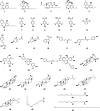Chemical constituents of industrial hemp roots and their anti-inflammatory activities
- PMID: 36642726
- PMCID: PMC9841654
- DOI: 10.1186/s42238-022-00168-3
Chemical constituents of industrial hemp roots and their anti-inflammatory activities
Abstract
Objective: Although the chemical constituents of the aerial parts of Cannabis have been extensively studied, phytochemicals of Cannabis roots are not well characterized. Herein, we investigated the chemical constituents of industrial hemp (Cannabis sativa L.) roots and evaluated the anti-inflammatory activities of phytochemicals isolated from the hemp roots extract.
Methods: An ethyl acetate extract of hemp roots was subjected to a combination of chromatographic columns to isolate phytochemicals. The chemical structures of the isolates were elucidated based on spectroscopic analyses (by nuclear magnetic resonance and mass spectrometry). The anti-inflammatory effects of phytochemicals from hemp roots were evaluated in an anti-inflammasome assay using human monocyte THP-1 cells.
Results: Phytochemical investigation of hemp roots extract led to the identification of 32 structurally diverse compounds including six cannabinoids (1-6), three phytosterols (26-28), four triterpenoids (22-25), five lignans (17-21), and 10 hydroxyl contained compounds (7-16), three fatty acids (29-31), and an unsaturated chain hydrocarbon (32). Compounds 14-21, 23, 27, and 32 were identified from the Cannabis species for the first time. Cannabinoids (1-5) reduced the level of cytokine tumor necrosis-alpha (by 38.2, 58.4, 47.7, 52.2, and 56.1%, respectively) and 2 and 5 also decreased the interleukin-1β production (by 42.2 and 92.4%, respectively) in a cell-based inflammasome model. In addition, non-cannabinoids including 11, 13, 20, 25, 29, and 32 also showed selective inhibition of interleukin-1β production (by 23.7, 22.5, 25.6, 78.0, 24.1, 46.6, and 25.4%, respectively) in THP-1 cells.
Conclusion: The phytochemical constituent of a hemp roots extract was characterized and compounds from hemp roots exerted promising anti-inflammatory effects.
Keywords: Cannabinoids; Cannabis sp. phytochemicals; Hemp; Inflammasome.
© 2023. The Author(s).
Conflict of interest statement
J.X. received funding from a research contract between Mawang Shenzhen Co. Ltd and Sun Yat-sen University (HT-99982019-0530). Mawang Shenzhen provided the materials of hemp roots but did not involve in the design, investigation, and presentation of this study. Other authors declare no competing interests.
Figures



Similar articles
-
Deciphering the Phytochemical Potential of Hemp Hairy Roots: A Promising Source of Cannabisins and Triterpenes as Bioactive Compounds.Molecules. 2024 Dec 7;29(23):5792. doi: 10.3390/molecules29235792. Molecules. 2024. PMID: 39683949 Free PMC article.
-
Identification of p-Coumaric Acid and Ethyl p-Coumarate as the Main Phenolic Components of Hemp (Cannabis sativa L.) Roots.Molecules. 2022 Apr 27;27(9):2781. doi: 10.3390/molecules27092781. Molecules. 2022. PMID: 35566134 Free PMC article.
-
Uncovering the metabolite complexity and variability of cultivated hemp (Cannabis sativa L.): A first phytochemical diversity mapping in Greece.Phytochemistry. 2024 Jun;222:114076. doi: 10.1016/j.phytochem.2024.114076. Epub 2024 Apr 1. Phytochemistry. 2024. PMID: 38570005
-
Metabolic Engineering Strategies of Industrial Hemp (Cannabis sativa L.): A Brief Review of the Advances and Challenges.Front Plant Sci. 2020 Dec 8;11:580621. doi: 10.3389/fpls.2020.580621. eCollection 2020. Front Plant Sci. 2020. PMID: 33363552 Free PMC article. Review.
-
Cannabis sativa: The Plant of the Thousand and One Molecules.Front Plant Sci. 2016 Feb 4;7:19. doi: 10.3389/fpls.2016.00019. eCollection 2016. Front Plant Sci. 2016. PMID: 26870049 Free PMC article. Review.
Cited by
-
Phytochemical Composition and Antioxidant Activity of Various Extracts of Fibre Hemp (Cannabis sativa L.) Cultivated in Lithuania.Molecules. 2023 Jun 22;28(13):4928. doi: 10.3390/molecules28134928. Molecules. 2023. PMID: 37446590 Free PMC article.
-
Deciphering the Phytochemical Potential of Hemp Hairy Roots: A Promising Source of Cannabisins and Triterpenes as Bioactive Compounds.Molecules. 2024 Dec 7;29(23):5792. doi: 10.3390/molecules29235792. Molecules. 2024. PMID: 39683949 Free PMC article.
-
Protective Effects of Hemp (Cannabis sativa) Root Extracts against Insulin-Deficient Diabetes Mellitus In Mice.Molecules. 2023 Apr 29;28(9):3814. doi: 10.3390/molecules28093814. Molecules. 2023. PMID: 37175224 Free PMC article.
-
Introduction to the special issue: the two sides of hemp: medical and industrial.J Cannabis Res. 2024 Jul 16;6(1):30. doi: 10.1186/s42238-024-00237-9. J Cannabis Res. 2024. PMID: 39010234 Free PMC article. No abstract available.
-
Hemp cultivation opportunities for marginal lands development.PLoS One. 2024 Mar 21;19(3):e0299981. doi: 10.1371/journal.pone.0299981. eCollection 2024. PLoS One. 2024. PMID: 38512945 Free PMC article.
References
-
- Bennett RD, Norman SM, Maier VP. Intermediate steps in the biosynthesis of abscisic acid from farnesyl pyrophosphate in Cercospora rosicola. Phytochemistry. 1990;29(11):3473–7. doi: 10.1016/0031-9422(90)85260-M. - DOI
-
- Chen HH, Chen YT, Huang YW, Tsai HJ, Kuo CC. 4-Ketopinoresinol, a novel naturally occurring ARE activator, induces the Nrf2/HO-1 axis and protects against oxidative stress-induced cell injury via activation of PI3K/AKT signaling. Free Radic Biol Med. 2012;52(6):1054–66. doi: 10.1016/J.FREERADBIOMED.2011.12.012. - DOI - PubMed
Grants and funding
LinkOut - more resources
Full Text Sources

